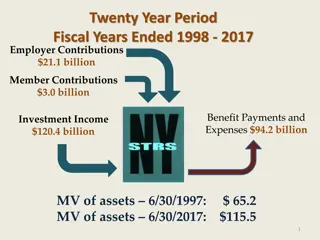
Exploring Servant Leadership's Impact on Life Satisfaction Through Career Commitment
This study addresses gaps in research by examining the relationship between servant leadership, career commitment, and life satisfaction. With limited existing research in this area, the study aims to contribute valuable insights into how servant leadership influences life satisfaction through career commitment.
Download Presentation

Please find below an Image/Link to download the presentation.
The content on the website is provided AS IS for your information and personal use only. It may not be sold, licensed, or shared on other websites without obtaining consent from the author. If you encounter any issues during the download, it is possible that the publisher has removed the file from their server.
You are allowed to download the files provided on this website for personal or commercial use, subject to the condition that they are used lawfully. All files are the property of their respective owners.
The content on the website is provided AS IS for your information and personal use only. It may not be sold, licensed, or shared on other websites without obtaining consent from the author.
E N D
Presentation Transcript
Sample Framework Career Commitment (MV) Servant Leadership (IV) Life Satisfaction (DV)
What are Your Gaps? The Contributions of the study are written based on the Gaps identified There is significantly limited research on the relationship between servant leadership and life satisfaction (Chughtai, 2019) Existing research has called for further research into both career and life satisfaction. Despite the progress in the career satisfaction literature, the research is significantly limited and requires further exploration (Jiang et al., 2016). The literature is almost silent on the mechanism of impact of servant leadership on life satisfaction (Li et al., 2018). Additionally, Chughtai (2018) has asked for the inclusion of career satisfaction as a mediating variable between servant leadership and life satisfaction. Additionally, research in life satisfaction has been criticized due to its lack of focus on the work domain/organizational settings and has primarily focused on the non-working samples for instance students, adolescents, children and people having health issues (Loewe et al., 2014). The literature of life satisfaction is relatively new and has been flourishing rapidly (Cerci and Dumludag, 2019). Furthermore, the role, leaders can play in improving the life satisfaction of followers has received scarce empirical consideration (Chughtai, 2018). Additionally, the authors could only find little research into life satisfaction in higher education that too in context of students (see Jamaludin et al., 2018; Hawi and Samaha, 2017).
Step 1: Where to Start When starting to write the research contributions, a research scholar should start with the following sentence. The present study attempts to address multiple gaps and in doing so makes important contributions.
Step 2: Number Your Contributions Number Your Contributions It is always recommended to number the contributions as first, second, third and so on. Based on the identified gaps, following research contributions are identified. In this case, the first contribution is based on the relationship between the independent and dependent variable and is written as First, the study extends the limited research on the understanding of Servant Leadership and its impact on life satisfaction. Our study is one of the first to consider servant leadership as an important antecedent of life satisfaction. Next, since the study has a mediating variable, the second contribution highlights the mediating variable, but also further explains that the study will add to the literature by further explaining the mechanism through which servant leadership impact life satisfaction. Second, assess the mediating role of career commitment between servant leadership and life satisfaction. Thus, explaining the mechanism through which servant leadership can influence life satisfaction. Next, if a scholar is testing a relationship that hasnt been tested before (to the best of authors knowledge and through search in peer reviewed databases), following example may be used to present the research contributions. Third, No previous study to the best of author s knowledge and through search in peer-reviewed databases has empirically explored the effects of servant leadership on these two work outcomes in an academic setting. However, research has shown that servant leadership can increase employees satisfaction with life in settings other than higher education (see Chughtai, 2018; Hakanen and Van Dierendonck, 2013). If the research is being done in a new setting where there is very limited research, the scholar may formulate the research contributions as Fourth, Existing research on Servant Leadership, Career Commitment, and Life Satisfaction has primarily focused on settings other than higher education. This is one of the earlier studies to assess servant leadership and its impact on employee work-related outcomes in higher education institutions.
Step 3: Add the Theoretical Lens and Add the Theoretical Lens and Contribution to the Theory Contribution to the Theory First mention the which theory you want to use in the study When the scholar is adding the contributions to the theory, it must start with the identification of the theory utilized in the study. The scholar may do it as The theoretical lens for the study is Leader-Member Exchange (LMX) theory that supports the explanation of proposed relationship of servant leadership with career and life satisfaction. Next, Briefly Explain the Theory Once the theory used is clearly identified, the next step is to briefly explain what the theory means. For example LMX theory has been found to be a compelling theory for developing an understanding of the role of leadership in shaping different organizational behaviors (Tordera and Gonz lez-Rom , 2013). A key proposition of leader member exchange (LMX) theory (Graen and Cashman, 1975; Graen and Uhl-Bien, 1995) is that a high-quality dyadic relationship between leader and follower has a crucial role in shaping followers work-related outcomes (Breevart et al., 2015). Finally, Link the Theory with the Variables The final step is to link the Theory with the Variables in the Study in terms of the Originality and how contribution is made to the theory through the linkage between the variables. This may be done as Hence, based on leader member exchange (LMX) theory, the study intends to ascertain the importance of servant leadership in shaping career and life satisfaction. The study would add to the theoretical development by integrating leader-member exchange (LMX) theory with servant leadership and how it fosters career commitment and life satisfaction.
Complete Example The present study attempts to address multiple gaps and in doing so makes important contributions. First, the study extends the limited research on the understanding of Servant Leadership and its impact on life satisfaction. Our study is among the first to consider servant leadership as an important antecedent of life satisfaction. Second, assess the mediating role of career commitment between servant leadership and life satisfaction. Thus, explaining the mechanism through which servant leadership can influence life satisfaction. Third, No previous study to the best of author s knowledge and through search in peer-reviewed databases has empirically explored the effects of servant leadership on these two work outcomes in an academic setting. However, research has shown that servant leadership can increase employees satisfaction with life in settings other than higher education (see Chughtai, 2018; Hakanen and Van Dierendonck, 2013). Fourth, Existing research on Servant Leadership, Career Commitment, and Life Satisfaction has primarily focused on settings other than higher education. This is one of the earlier studies to assess servant leadership and its impact on employee work-related outcomes in higher education institutions. The theoretical lens for the study is Leader-Member Exchange (LMX) theory that supports the explanation of proposed relationship of servant leadership with career and life satisfaction. LMX theory has been found to be a compelling theory for developing an understanding of the role of leadership in shaping different organizational behaviors (Tordera and Gonz lez-Rom , 2013). A key proposition of leader member exchange (LMX) theory (Graen and Cashman, 1975; Graen and Uhl-Bien, 1995) is that a high-quality dyadic relationship between leader and follower has a crucial role in shaping followers work-related outcomes (Breevart et al., 2015). Finally, based on leader member exchange (LMX) theory, the study intends to ascertain the importance of servant leadership in shaping career and life satisfaction. The study would add to the theoretical development by integrating leader-member exchange (LMX) theory with servant leadership and how it fosters career commitment and life satisfaction.
What if there are more than 1 Theory? What if there are more than 1 Theory? A scholar may utilize more than one theory in a research paper/thesis. In such scenario, contribution is made in two theories. The following description will help researchers identify how to present contributions when multiple theories are utilized. First, I present a sample framework. The framework is based on the LMX Theory and Self-Efficacy Theory Career Commitment (MV) Servant Leadership (IV) Life Satisfaction (DV) Self-Efficacy (MV)
What if there are more than 1 Theory? What if there are more than 1 Theory? First mention theories. The research shall first mention the theories, an example is presented here The study relies on LMX theory and Self-Efficacy theory in explaining the role of servant leadership in leading to life satisfaction with mediating role of career commitment and self-efficacy. Next as was done in previous example in framework with one theory, here both the theories are briefly explained. Example is presented here LMX theory has been found to be a compelling theory for developing an understanding of the role of leadership in shaping different organizational behaviors (Tordera and Gonz lez-Rom , 2013). A key proposition of leader member exchange (LMX) theory (Graen and Cashman, 1975; Graen and Uhl-Bien, 1995) is that a high-quality dyadic relationship between leader and follower has a crucial role in shaping followers work-related outcomes (Breevart et al., 2015). Bandura (1977) posited that self-efficacy (SE) beliefs influenced the types of activity people chose to engage in, the level of effort they put in and their perseverance in the face of difficulties. Self- efficacy theory explains how self-efficacy develops and is altered, as well as how self-efficacy impacts behavioral change, performance accomplishments, and personal well-being (Lippke, 2020).
What if there are more than 1 Theory? What if there are more than 1 Theory? Finally, Link the Theory with the Variables Link the Theory with the Variables in the Study in terms of the Originality and addition not the theory through the linkage between the variables. A detailed example is presented. The present study integrates two theoretical approaches (i.e., LMS theory and self-efficacy theory). The current study extends the research concerning servant leadership and employee related outcomes (career commitment, self-efficacy, and life satisfaction) by investigating the distinct mechanisms of career commitment and self-efficacy by integrating LMX theory and self-efficacy theory. In doing so, it adds to the theoretical development by integrating leader- member exchange (LMX) theory and self-efficacy theory with servant leadership and how it fosters career commitment, self-efficacy, and life satisfaction.






















